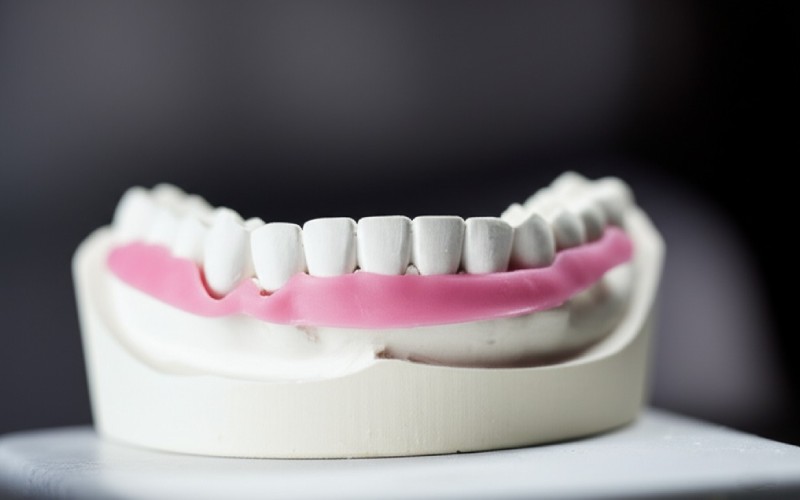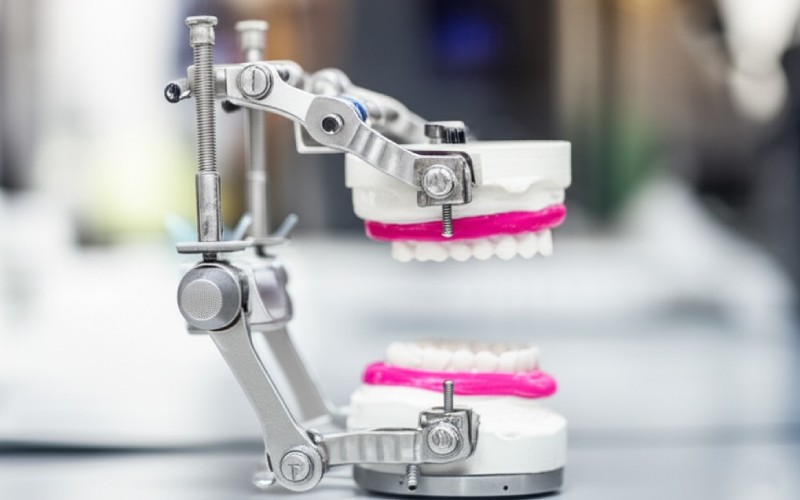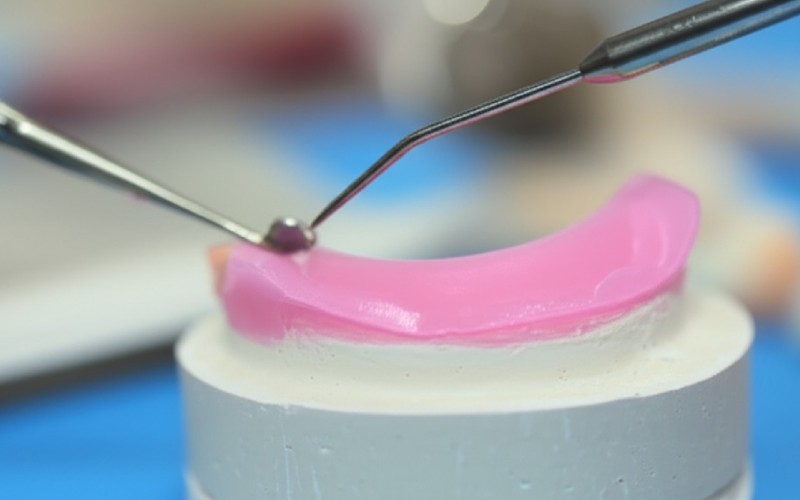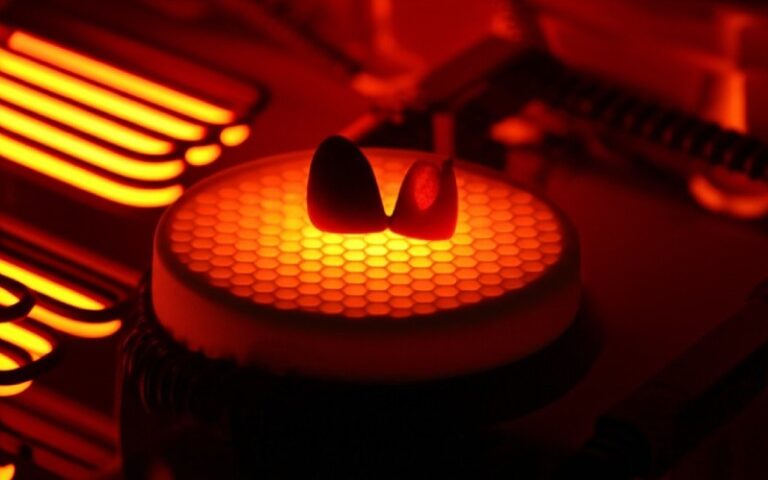
Le bordé en cire : Votre guide pour la réussite de la fabrication de prothèses dentaires
This article is about the wax rim and record base. These are key tools in making a good dentier. But there are many denture problems. Most come from a bad start in the fabrication process. A good wax rim helps get the bite record right. It makes sure your new tooth will look and feel good. Read this to learn how a simple piece of wax is so important for your new smile and an accurate fit.
Table des matières
What is a Wax Rim in Denture Fabrication?
Many people don’t know about the wax rim. It’s a simple name for a very important tool. A wax rim is a U-shaped block of wax. It is placed on a temporary denture plate called a record base. We use these two parts together. They help us figure out where your new denture teeth should go. Think of it as a blueprint for your smile. This preparation step is a cornerstone of good dentistry.
The record base with the wax rim on top is an analog model of your final denture. The record base sits on your gum ridge, just like the real denture will. The wax rim stands in for the teeth. It lets the dentist see and feel the space where the teeth are in contact. This simple wax block is the key to creating a comfortable and functional denture. The fabrication of this tool is the first step toward a successful prosthodontics outcome.
Without a well-made wax rim, the whole denture process can go wrong. An inaccurate wax rim can lead to a denture that does not fit well. It can cause problems with how you chew or speak. It can even make your face look different. That is why we spend so much time getting this one step right. This wax rim is a critical part of the record-taking procedure.
Why is the Occlusal Record So Important in Dentistry?
The occlusal record is a map of how your upper and lower jaws meet. We often call this your bite. Getting this record right is everything. If the occlusal record is wrong, your denture will be wrong. You might have a premature contact point, where one tooth hits before the others. This can cause pain, an unstable denture, and trouble eating. The wax rim is our main tool to get this vital record.
In the field of prosthodontics, we take great care to capture a perfect occlusal record. This record tells us three main things. First, it shows the side-to-side and front-to-back jaw relations. Second, it helps us find the right height between your jaws. We call this the vertical dimension of occlusion (or VDO). A proper VDO is key for both looks and function. The wax rim helps us capture this record with great accuracy.
A poor occlusal record can lead to a complete remake of a new denture. It’s a waste of time and money. It also causes a lot of frustration for the patient. A carefully made wax rim helps prevent these problems. It allows us to create a relation record that can be trusted. This makes the rest of the denture making process much smoother. This is a fundamental concept in dentistry.
How Do You Create the Record Base for a Denture?
Before we can even use a wax rim, we need something to put it on. This is the record base. The record base is a rigid, temporary plate. It must fit the patient’s mouth perfectly. The process starts with an impression of the patient’s gum ridge. From this impression, a stone model called a master cast is made. This cast is an exact copy of the patient’s mouth.
Once we have the master cast, we can make the record base. These bases are often made from a light-cured resin or acrylic. We adapt the resin material directly onto the cast. We make sure it is thin but strong. It must not rock or move on the cast. A stable record base is critical. If the base moves, any record we take with the wax rim will be wrong.
Double-check the record base. A good one fits snugly on the master cast and does not rub on the patient’s gums. This is the foundation for our wax rim. Once the record base is made and fits well, we are ready to add the wax rim itself. These temporary bases are essential for a good outcome.

What is the First Step in the Wax Rim Procedure?
The first step is attaching the wax to the record base. We start with a pre-formed roll of pink denture wax. It is firm at room temperature. We use a heated spatula or a small flame to soften the bottom of the wax roll. Then, we press it firmly onto the record base, right over the center of the gum ridge on the cast.
We then shape this wax into a neat, U-shaped block. This block is the wax rim. The goal is to build up the wax to the approximate height and width of the final denture teeth. We use a hot spatula to smooth the wax and fuse it to the record base. There should be no gaps or spaces. The wax rim must be a solid, single unit with its record base.
The initial shape of the wax rim is just a starting point. We create a basic form in the laboratoire dentaire. Then, the real work happens when the patient is in the chair. The dentist will trim and shape the wax rim inside the patient’s mouth. The goal is to make a custom blueprint for their new tooth arrangement. This preparation is key to a good occlusal record.
How Do You Determine the Correct Bite with a Wax Rim?
This is where the magic happens. The dentist places the record base and wax rim in the patient’s mouth. The first thing we determine is the correct height, or the vertical dimension of occlusion. We add or remove wax from the occlusal surface of the wax rim until the patient’s profile looks natural. We watch the space between the nose and chin. This is a critical adjustment.
Next, we establish the proper lip support. The anterior, or front part, of the wax rim should fill out the patient’s lip naturally. We don’t want the lip to look sunken or too puffy. We can add additional wax to the front of the wax rim to get the right contour. We also mark the midline on the wax rim. This line shows the center of the face. It helps us place the two front teeth correctly.
Finally, we guide the patient to close into their natural bite. We instruct the patient to relax and bite down gently. Their jaws should be in a resting, repeatable position. This gives us our centric relation records. We make small grooves in one wax rim and put a soft bite registration material on the other. When the patient closes, the material locks the two wax rim bases together. This is the bite record we need. This verification step is crucial.
What Role Does the Mandibular Wax Rim Play?
The mandibular or lower wax rim is just as important as the upper one. It works as a team with the upper rim to establish the patient’s jaw relations. The mandibular wax rim is made on a record base that fits the lower arch. It sits on the lower gum ridge. The height and shape of this wax rim are very important.
When we set up the occlusal plane, the mandibular wax rim helps us. The occlusal plane is the imaginary flat surface where the upper and lower teeth meet. In the mouth, we often set this plane to be level with certain landmarks. For example, the height of the mandibular wax rim in the back should be about two-thirds of the way up the retromolar pad, a small piece of tissue behind the last molar. The lingual and buccal shape of this wax rim is also important for tongue space and cheek support.
The mandibular wax rim is key for getting the final bite record. After we have set the height and contour of both the upper and lower rims are used, we guide the patient to close. This action captures the relationship between the two jaws. The mandibular record is critical for making a stable and comfortable lower denture, which is often the harder one to get right.
Can This Fabrication Method Be Used for Partial Dentures?
Yes, absolutely. While we often talk about the wax rim for full dentures, the same ideas are used for partial dentures. A partial denture replaces only a few missing teeth. It uses the remaining natural teeth for support. But we still need to know how the new denture teeth will meet the teeth in the opposite arch.
For a partial denture, we still build a record base and a wax rim in the empty spaces. This wax rim is then used to record the bite. It allows us to articulate the stone cast of the patient’s mouth with the opposing cast. This means we can line them up correctly. This step is vital to make sure the new artificial teeth on the partial denture have the correct occlusal relationship.
The process might be a little simpler than for a full denture. We already have natural teeth to guide us. But the principle is the same. The wax rim serves as a temporary stand-in. It helps us get a perfect occlusal record so the final partial dentures will fit and function well with the existing tooth structure. The goal is always a harmonious bite.
How Do Prosthodontics Experts Adjust the Occlusal Plane?
Adjusting the occlusal plane is an art and a science. This is a core skill in prosthodontics. The occlusal plane is the level where the upper and lower teeth will meet and chew. We use the wax rim to create this plane. We start with the upper wax rim. The front edge, or incisal edge, should be visible just slightly below the upper lip when the patient smiles.
We use a special tool called a Fox plane. It’s a flat plate with a handle. We hold it against the occlusal surface of the wax rim. This helps us see if the plane is level. The anterior part of the occlusal plane should be parallel to the line between the pupils of the eyes. The side, or lateral, part of the plane should be parallel to a line running from the corner of the nose to the ear. We trim or add wax to the wax rim to achieve this. We desire to create a natural smile line.
We then adjust the lower, or mandibular, wax rim to meet this newly established occlusal plane. The height of the posterior, or back, section near the molar area is critical for function. Once both rims are perfectly contoured and meet evenly, we can take the final bite record. The wax rim is contoured to create the ideal foundation for the denture teeth. This adjustment procedure is vital for a good result. We may have to alter the wax rim several times.
What Happens After the Wax Rim Record is Complete?
Once we have our perfect jaw relation records locked into the wax rim bases, the patient’s job is done for the day. Now, the work goes back to the dental laboratory. We take the two casts, with their record base and wax rim sets still attached, and we mount them on a device called an articulator. An articulator is a mechanical jaw that copies the patient’s chewing movements.
The wax rim allows us to mount the upper and lower casts in the exact same relationship as they are in the patient’s mouth. This is a critical transfer of information. The articulator holds the casts in this fixed position. Now, the technician can remove the wax rim and begin to arrange the artificial denture teeth. The space that the wax rim occupied is exactly where the new teeth will go. The wax rim has given us the blueprint for tooth position and angulation.
The articulator lets us check the bite and movements before the denture is even made of acrylic. We can see how the teeth will meet. We can check for any issues with the buccal or lingual placement of each tooth. The information from the wax rim record is everything. If that record is good, the technician can set the teeth with confidence. This information may be reproduced on the articulator. This confirmation step is key.
Why is Accuracy So Critical in This Denture Procedure?
I cannot say this enough: accuracy is the name of the game. Every single step in this denture procedure builds on the last one. A small error at the start can become a huge problem at the end. The wax rim stage is where many of these errors can happen. An inaccurate occlusal record taken with a poor wax rim is a recipe for failure.
If the bite record is wrong, the technician on the articulator will set the teeth in the wrong position. When this denture is placed in the patient’s mouth, it will not fit or feel right. The bite will be off. This requires a lot of chairside adjustment time or even a complete remake. This is why we are so careful when we fabricate and use the wax rim. The thickness and contour must be perfect.
A great denture starts with a great impression and a great master cast. It continues with a stable record base and a perfectly shaped wax rim. These centric relation records allow us to build a denture that feels like a part of the patient. The goal is to create a final denture base with teeth that function well, look good, and are comfortable to wear. That journey to accuracy starts with a simple block of wax. We need to verify every step. That is why this wax rim procedure is so important in dentistry.

Ce qu'il faut retenir
- A wax rim is a wax block on a record base used to create a blueprint for a new denture.
- It is used to record the occlusal relationship, or bite, between the upper and lower jaws.
- The wax rim helps determine the correct tooth position, lip support, and smile line.
- The procedure involves creating a stable record base from a cast, adding the wax rim, and shaping it in the patient’s mouth.
- The final record is transferred to an articulator, which copies the jaw movements and allows for the proper arrangement of the denture teeth.
- Accuracy at the wax rim stage is critical to avoid problems like a poor bite, discomfort, and the need for major occlusal correction.




